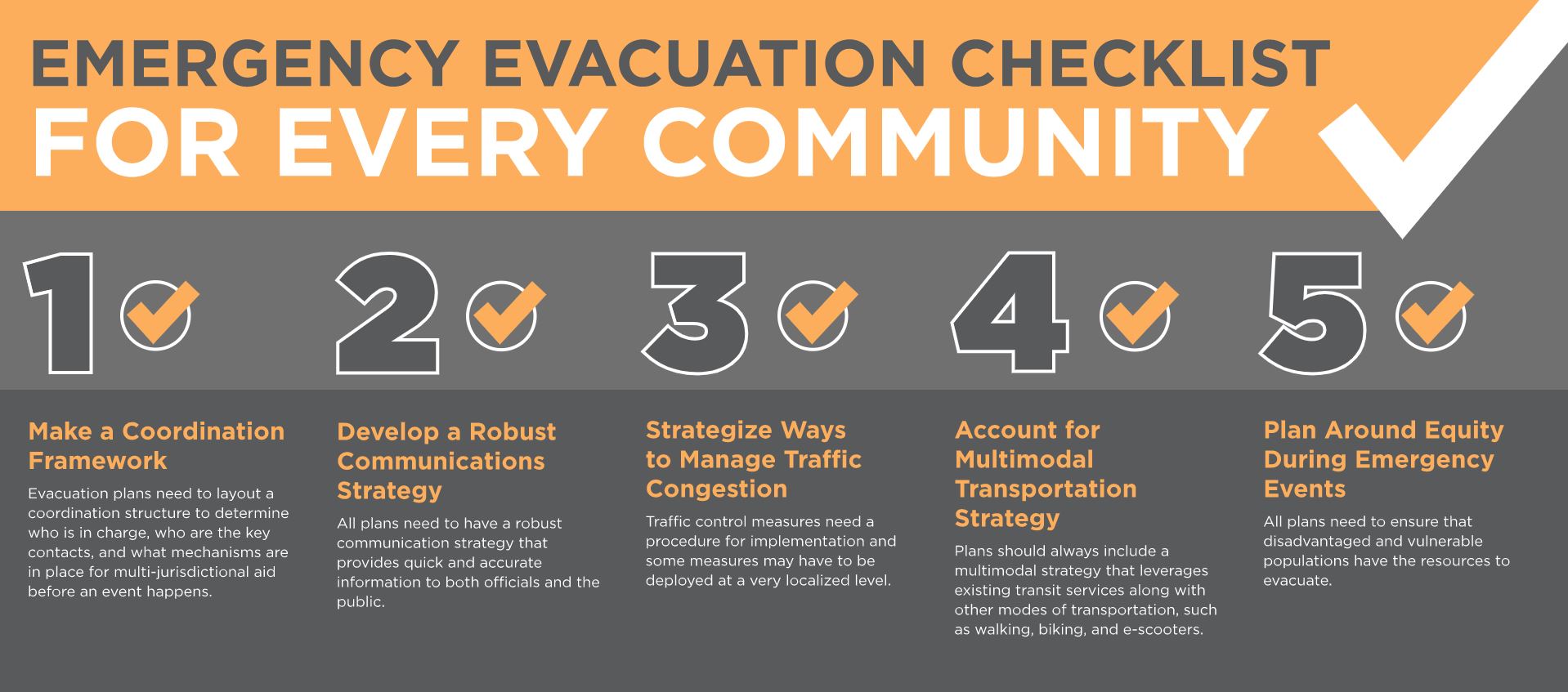November 13, 2019
Emergency evacuations and resilience planning are increasingly important topics for many reasons. Here are two key points that are top-of-mind:
#1: The substantial and increasing number of disasters requiring mass evacuations. With ongoing climate change, these large natural disasters will become more frequent.
#2: A pattern of urban environments pushing up against wildland interfaces caused by growing populations. As people continue to develop and build in high-risk areas, the number of individuals requiring evacuations will continue to grow.
At its core, transportation resilience is about systems working together to provide flexible and resilient infrastructure that helps people move safely through natural disasters or other major challenges. Resilience planning and emergency management are important elements of the safety work we do here at Kittelson. We have been excited to partner on projects with Stephen Wong, incoming assistant professor at the University of Alberta, who researches the elements of successful emergency evacuation strategies. We reached out to Stephen for his insights on high-level strategies every agency should implement to “plan for the unpredictable.”
Applying Research Findings on Evacuation Planning in Emergency Management
Stephen’s research involves developing empirically driven evacuation strategies for agencies to prepare for, respond to, and recover from disasters.
Within this overarching theme, Stephen focuses on two aspects of evacuations that inform resilience planning. The first aspect is how individuals make decisions during emergency evacuations (i.e., whether or not to evacuate, which route to take, what mode of transportation to use, and when to leave).
Using post-disaster survey data from hurricanes and wildfires, and other methods of modeling behavior, Stephen assesses factors that influence individuals to make these decisions. This helps him recommend specific policies and strategies for improving emergency evacuation plans.
The second aspect of Stephen’s research is how we can leverage the sharing economy, whether private or public, in an evacuation or emergency event. The sharing economy could provide supplemental resources to public agencies in large disasters, specifically transportation and sheltering resources. He studies the feasibility of these resources through post-disaster surveys, analyzes the willingness of individuals to provide these resources, and ground-truth strategies with vulnerable populations to increase equitable outcomes.
Emergency Evacuation Strategies Every Community Should Have
While every community’s setup and needs are different, several key strategies are crucial for all communities and evacuations, regardless of the hazard. Stephen shares five key considerations for agencies to develop an effective emergency evacuation plan that emerged from his research.
1. Create a Coordination Framework
Evacuation plans need to lay out a coordination structure to determine who is in charge, who are the key contacts, and what mechanisms are in place for multi-jurisdictional aid before an event happens. Adding this framework to any resilience plan will fortify communication to mitigate the risks of sudden and unexpected events.
2. Develop a Robust Communications Strategy
Plans should have a robust communication strategy to provide quick and accurate information to officials and the public. This is especially important for delivering evacuation orders, which need to be proactive and communicated across a broad spectrum of channels during fires, hurricanes, or any other emergency event.
3. Plan to Manage Traffic Congestion
Traffic control measures need an implementation procedure and some measures may have to be deployed at a very localized level. The evacuation strategy should include moving people away from a disaster on roadways that aren’t typically equipped to handle high traffic volumes.
4. Account for Multimodal Transportation Strategy
Plans should include a multimodal strategy that leverages existing transit services, along with other modes of transportation, such as walking, e-scooters, and biking. While the deployment of these services may not be rapid enough during the evacuation response, accounting for transit in any resilience plan is a crucial element for preparing and recovering communities.
5. Plan Around Equity During Emergency Events
Plans should specifically serve disadvantaged and vulnerable populations and include resources to evacuate. This may require developing other means of gathering resources, alternative communication methods, and specialized training so life safety is included in any resilience plan.

Understand Your Evacuation Plans
Be nimble. One key misconception Stephen notes is that all evacuation plan elements will be usable in a disaster.
“More often than not, over half the plan is thrown out the window in a disaster due to the unique characteristics of the event,” says Stephen. “Evacuation plans are simply unable to address all potential outcomes, particularly for the worst-case scenario. However, the groundwork laid while building the plan (coordination structure, communication, congestion strategies, transit plans, safety for vulnerable population) is still valuable and will allow for a quicker and more efficient response that will save lives and improve community recovery.”
In summary, evacuation plans are guidelines to assist officials during stressful events like wildfires, hurricanes, flooding or any other disaster. As such, emergency plans should be tested and regularly revisited to support their success.
How Technology Plays a Role in Evacuation and Resilience Planning
Technology has advanced communication, allowing officials to provide warnings and information across a number of platforms. GIS and simulations of fire and traffic offer scenario testing and can help pinpoint key challenges communities face before a disaster happens.
“Technology also helps individuals connect with each other, increasing the number of resources available to the community through the sharing economy,” says Stephen. “Finally, technology helps us detect hazards faster and monitor traffic in real-time through sensors, while also improving situational knowledge via crowdsourcing and providing wildfire monitoring through drones.”
However, Stephen stresses that many technological improvements may be unusable in disasters. Consequently, evacuation plans need creative low-tech solutions to provide rapid response even without the benefits of technology.
The Role Transportation Planning and Resilience Planning Has in an Emergency Event
Because natural disasters are unpredictable by definition, the most resilient transportation system is the most nimble one. It provides different forms of transportation to give people options during an emergency event by giving them alternatives to driving that could prevent a roadway from getting choked by single-occupancy vehicles. Evacuation by car also isn’t an option for people who don’t own a vehicle or for those with disabilities that can’t drive.
We know this is not an easy topic to address head-on, and for some, it may come with the association of natural disasters that affected the lives of people you know or communities near you. In situations like these, you have seen firsthand how “resilience” can extend beyond being a transportation concept, becoming the descriptor of a community that faces tragedy with strength and moves forward in what initially seems like an impossible feat.
At Kittelson, we read and hear about these stories with admiration. And every one of them adds an underscore to the importance of this topic. Because ultimately, it isn’t just about data, strategy, or framework plans – it’s about real people’s lives, and protecting them in all the ways that we can.
The transportation industry is fortunate to play a role in supporting communities’ preparation for safe and efficient emergency response. It’s a topic that is worth immense time and effort from all of us. With any comments, questions, or additional thoughts, please don’t hesitate to reach out to us to discuss further.

